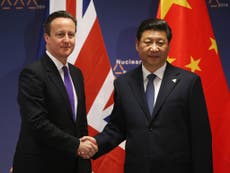India’s population rise puts it on course for rapid growth
The workforce in India has to be effectively employed, and that is a function of education, investment and technology


In about five years’ time, India will pass China to become the world’s most populated country, which gives an immediate edge to the welcome that the UK will roll out for Narendra Modi, India’s Prime Minister, this week. This is not a state visit like that accorded to China last month, for Modi is the head of government rather than the head of state. But on the red-carpet scale it is similar, including lunch with the Queen, and – something that the Chinese leadership did not do – a mass rally with 60,000 of the British-Indian community at Wembley Stadium. In the space of three weeks, Britain will have played host to the leaders of 40 per cent of the world’s population.
There is a particular link with India: the country’s investment here. The Tata Group, notwithstanding the job losses in steel, is Britain’s largest manufacturing employer, and Modi will be visiting one of its Jaguar Land Rover factories.
There is, of course, a political dimension to the visit, and Modi is seen by many as a divisive figure. There is also some pushback against his platform of economic reform, for his Bharatiya Janata Party lost important state elections in Bihar last week. From a British perspective, however, this is about economics. Irrespective of whatever happens to our relationship with Europe, our economic ties with China and India will become more important. China will almost certainly pass the US to become the world’s largest economy by 2040, while at about the same time India will pass Japan to become No 3. The China/India story will dominate economics for the next generation.
Up to now, the focus has been more on China, for what happens there is of paramount importance to things that affect the rest of the world, including commodity and energy prices. But the helter-skelter growth of the past is slowing; this year, it looks as though growth in India will be faster than in China. This will affect the rest of us. For example, the new World Energy Outlook, produced by the Organisation for Economic Co-operation and Development and the International Energy Agency, predicts that India will contribute more than any other country to increased energy demand in the years to 2040.
Oversimplifying a bit, economic growth is driven mainly by two factors: the size of the working population, and the pace of technological progress. The first is pretty straightforward, the second much less so.
We can say quite a lot about demography, with reasonable confidence, for the next three decades. While the total population of China will peak in about 10 years, India’s will not peak until after 2050. We know that the population of working age in China has already started to fall, whereas that of India will rise for another half-century. Curiously, the ending of the one-child policy in China does not change things very much, because there is a strong trend among Chinese people to have smaller families anyway. Three of the four administrative regions in the world with the lowest fertility rates are Chinese communities: Singapore, Macao and Hong Kong. In India, while fertility rates are falling, they are likely to remain above replacement rate for another generation.
So in the size of the workforce, the big winner is India. But if living standards of people are to rise, that workforce has to be effectively employed, and that is a function of education, investment and technology. Here India’s record is uneven. In education, the best is very good, but much of the population growth is in poorer, less developed regions where education remains weak. UN figures show India to have the largest number of illiterate adults in the world: 287 million, or 37 per cent of the global total. Literacy is rising, but still reached only 63 per cent in 2006, the latest year for which figures are available.
Investment? Here again the record is uneven. If you take infrastructure, a huge effort is being made. Internal airlines have improved hugely since the airways were opened to competition in the 1990s. Roads have been improved, too, with a new national network of dual carriageways linking major cities. The big missing link has been inward foreign direct investment (FDI).
The key point here, as China appreciates, is that such inward investment also brings in technology and access to foreign markets. Just yesterday, India eased controls on inward investment in 15 sectors including defence, broadcasting, construction and retail. That is fine (except that the existence of such restrictions says a lot about the country’s reservations); however, the latest data does show a boom in inward FDI in the first half of this year, which if sustained would suggest the Modi programme is working. India has also climbed up a few places in the World Economic Forum’s list of countries’ competitiveness, rising to No 55, which may not sound great but is decent progress. When investment decisions are being made, direction of travel is probably more important than actual position in a league table.
There are many other challenges. One particularly divisive issue is growing inequality. Mumbai is a wonderful city, but it does have the dubious distinction of having the world’s most expensive private home, “Antilia”, a jagged 27-storey tower block that looks like an office building and cost billionaire Mukesh Ambani $1bn to construct. It is certainly an example of extreme inequality. Ratan Tata, the former head of the Tata Group, who lives in a modest but comfortable apartment near the southern tip of the city, cited Antilia as an example of rich Indians’ lack of empathy for the poor. The big question, then, is whether the rise in economic inequality is a temporary phenomenon that will be eroded as overall wealth levels rise. As recently as the early 1980s, income per head in India was higher than that of China. If the country can sustain a quarter-century of growth at high single digits, as China has done, it will pull hundreds of millions of people out of poverty. The prize is huge, and for the grasping.



Join our commenting forum
Join thought-provoking conversations, follow other Independent readers and see their replies